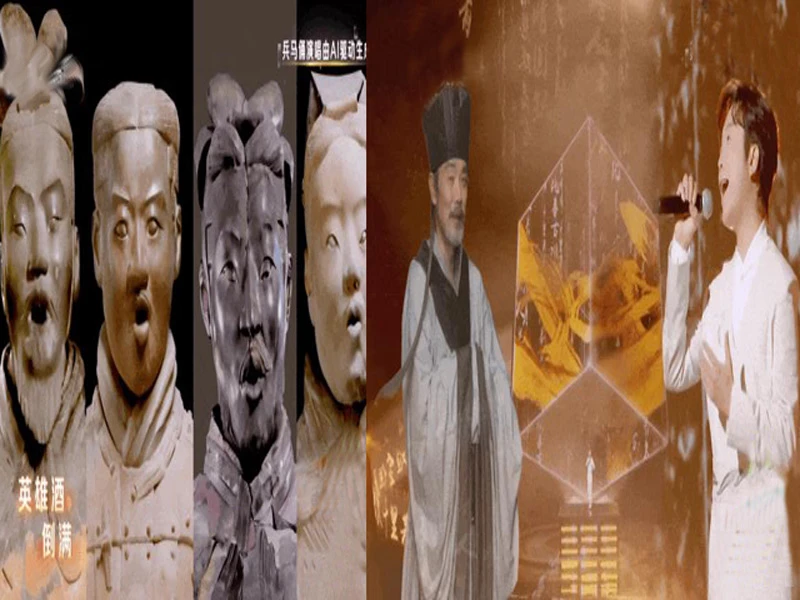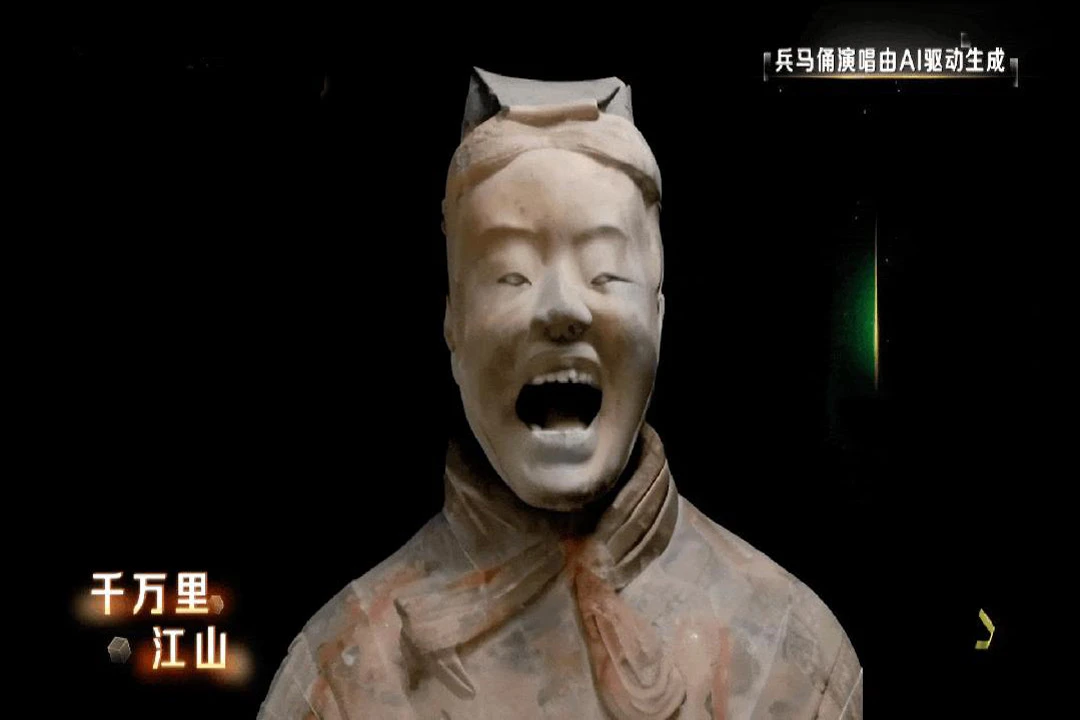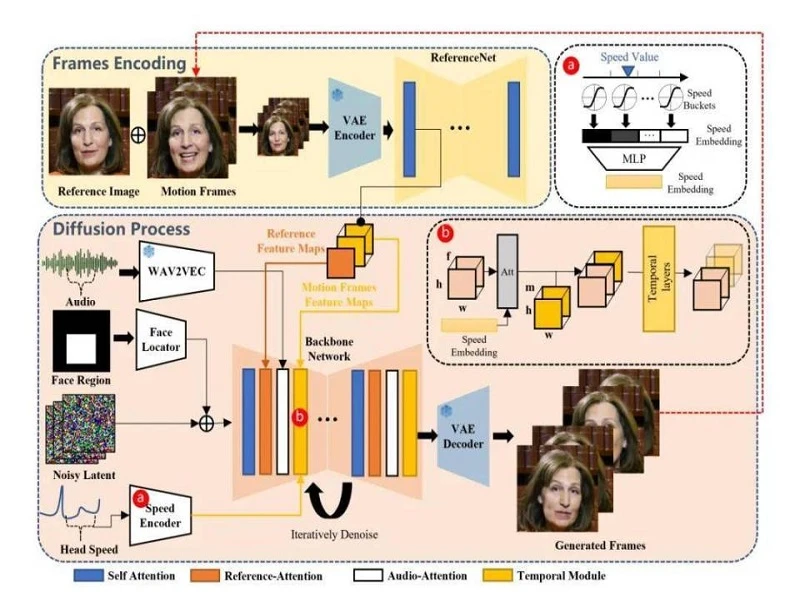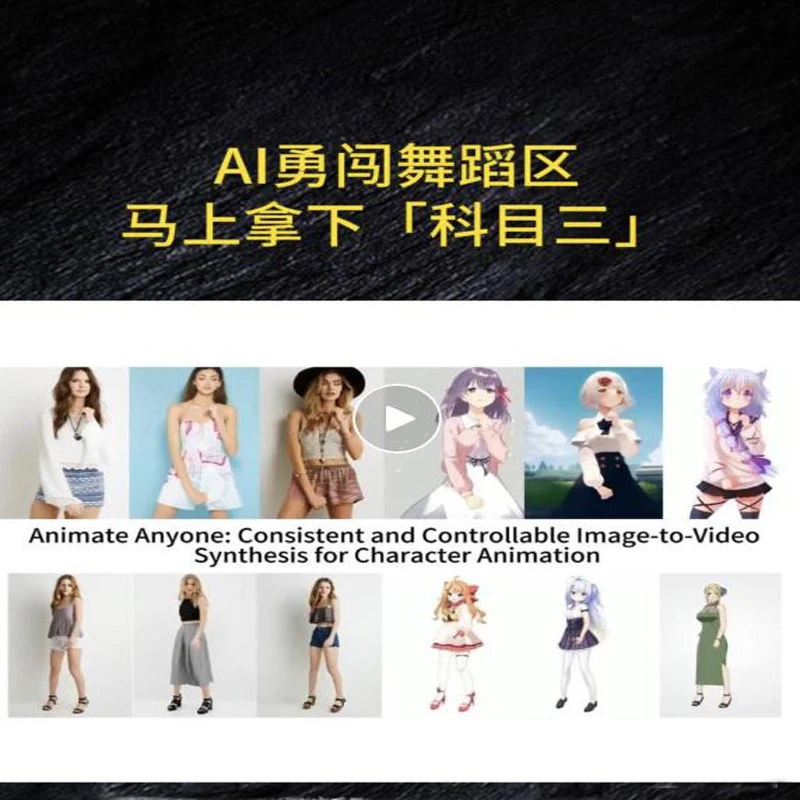The Terracotta Warriors, sleeping for more than 2,000 years, have awakened?
A Qin opera opens the show, transporting us to the Loess Plateau. If they hadn't seen it with their own eyes, it would have been hard for many audience members to imagine seeing the Terracotta Warriors and Jewel Gem (A famous Chinese rapper) singing "Marching from the Army (从军行)" on the same stage in their lifetime.
"The long clouds of the green sea darken the snowy mountains, and the lonely city looks at the Jade Gate Pass in the distance." Although the ancient tune has changed, the voice still moves people.
The "AI Resurrection Summoning Technique" behind this performance is called EMO, which comes from Alibaba Tongyi Lab. With just a photo and an audio, EMO can turn a static image into an exquisite singing video, and accurately pinpoint the ups and downs, rhythm and staccato in the audio.
In CCTV's "2024 China AI Ceremony", also based on EMO technology, the Northern Song Dynasty writer Su Shi was "resurrected" and sang "Prelude To Water Melody (水调歌头)" with Li Yugang on the same stage. "AI Su Shi's movements were simple and natural, as if he had traveled through time and space. In a spectacle that could only be imagined in dreams, the ancient Terracotta Warriors of China took the stage alongside contemporary talent Gem in a mesmerizing rendition of the traditional Chinese poem "Song of the Army Formation." This groundbreaking performance, featured at the 2024 China AI Summit broadcasted on CCTV, wasn't just about bringing history to life—it was about showcasing the pinnacle of AI technology in artistic expression.
At the heart of this technological marvel lies EMO, an innovative creation from Alibaba's Tongyi Laboratory (阿里巴巴通义实验室). EMO, short for Emote Portrait Alive, developed by Alibaba's Tongyi Lab, employs advanced AI algorithms to animate static images and audio into lifelike performance videos. This groundbreaking technology has not only revived historical figures like Song dynasty literati Su Shi but also allowed them to collaborate seamlessly with contemporary artists.
EMO utilizes cutting-edge AI techniques to transform static images into lifelike performance videos with remarkable precision. Whether it's resurrecting historical figures like Song dynasty poet Su Shi or animating ancient statues, EMO demonstrates its prowess in merging media, technology, and artistry.
The Technological Frontier: EMO's Innovation and Impact
EMO represents a quantum leap in AI-driven video generation, particularly in overcoming the challenges of audio-driven character animation. Unlike traditional methods that rely on 3D modeling or facial keypoint tracking, EMO's innovation lies in its "weak control design," which extracts facial expressions and lip-sync directly from audio inputs. This approach not only reduces production costs but also enhances the emotional depth and realism of generated videos.
Central to EMO's success is its vast and diverse dataset, encompassing over 250 hours of video footage and 150 million images. This comprehensive database includes speeches, films, TV clips, and musical performances in multiple languages, ensuring that EMO learns from a broad spectrum of human expressions and vocal styles.
While EMO has marked a significant leap forward in AI technology, challenges persist in scaling up models for professional-grade content creation. The future of video generation lies in harnessing advanced techniques like the Diffusion Transformer (DiT), which promises even greater fidelity and realism in video outputs.
Charting the Course: Future Directions in Video Generation
The success of EMO underscores the growing demand for AI technologies that can handle complex creative tasks. As video content proliferates across digital platforms, there is a pressing need for tools that can deliver professional-grade results seamlessly. EMO's ability to generate high-quality, emotionally resonant content directly from audio inputs positions it as a pivotal tool in the arsenal of media professionals and content creators.
Looking ahead, the field of video generation is poised for further innovation. Technologies like EMO pave the way for new paradigms in content creation, where AI not only augments human creativity but also expands the boundaries of what is artistically achievable. Whether through enhancing historical reenactments or enabling unprecedented collaborations, EMO exemplifies the transformative power of AI in shaping the future of media and entertainment.
Redefining Artistic Boundaries
The integration of EMO technology at the 2024 China AI Summit not only showcased its technical prowess but also sparked a broader conversation about the intersection of technology and culture. Beyond entertainment, EMO holds promise in revitalizing cultural heritage, offering new avenues for storytelling and educational engagement. Imagine historical figures like Confucius or Mulan stepping off the pages of textbooks to impart wisdom through interactive AI-driven experiences, transcending time and space to inspire future generations.
The implications of EMO extend far beyond artistic performances. In educational settings, AI-generated content can revolutionize how history and literature are taught, making complex subjects more accessible and engaging for students. By animating historical events or literary characters, EMO fosters immersive learning experiences that bring the curriculum to life, bridging the gap between ancient texts and modern classrooms.
Ethical Considerations and Challenges
As with any transformative technology, EMO raises ethical considerations regarding authenticity, representation, and cultural sensitivity. The use of AI to animate historical or cultural figures must be approached with caution, ensuring that depictions are respectful and accurately reflect their significance. Moreover, there are concerns about the impact of AI on human creativity and employment in creative industries, highlighting the need for ethical guidelines and responsible deployment of AI technologies.
Looking Ahead: The Future of EMO Technology
The success of EMO at the 2024 China AI Summit underscores its potential for fostering global collaboration in the arts and technology sectors. By enabling cross-cultural exchanges and creative collaborations, EMO can transcend linguistic and geographical barriers, promoting cultural understanding and appreciation on a global scale. International partnerships leveraging EMO could further amplify its impact, facilitating joint projects that celebrate diversity and shared cultural heritage.
As EMO continues to evolve, future developments may focus on enhancing its capabilities in facial and gesture recognition, voice modulation, and real-time interaction. These advancements could unlock new possibilities in virtual performances, interactive storytelling, and personalized content creation, catering to diverse audience preferences and creative objectives. Additionally, integrating EMO into virtual reality (VR) and augmented reality (AR) platforms could offer immersive experiences that blur the lines between physical and digital realities.
The debut of EMO technology at the 2024 China AI Summit marks a pivotal moment in the evolution of AI-driven entertainment and cultural preservation. By harnessing the power of AI to animate historical and artistic expressions, EMO not only entertains but also educates, inspires, and connects audiences worldwide.
As we stand at the crossroads of history and technology, EMO represents more than just a technological breakthrough—it embodies the creative possibilities that AI brings to cultural preservation and artistic expression. From the ancient halls of Xi'an to the global stage of the 2024 China AI Summit, EMO has redefined how we perceive and interact with history, demonstrating that with innovation, even the stones of the past can sing.




